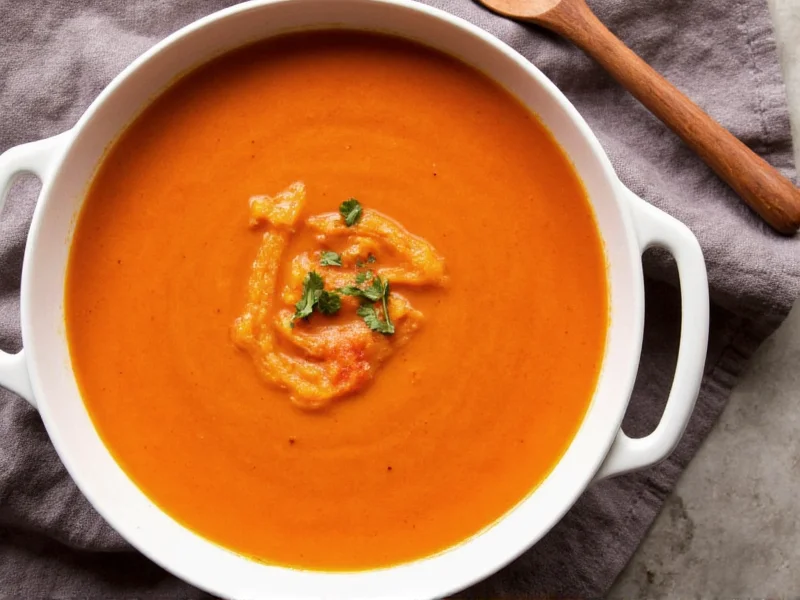Why Roasting Transforms Tomato Soup Flavor
Roasting tomatoes isn't just a cooking technique—it's a flavor transformation. When tomatoes hit 300°F (150°C), the Maillard reaction begins, creating complex flavor compounds that raw or boiled tomatoes can't match. This easy roasted tomato soup recipe leverages caramelization to develop deep umami notes while reducing natural acidity. Professional chefs consistently prefer roasted over boiled tomatoes for soup because roasting concentrates flavors by evaporating excess water content, yielding a richer base that doesn't require heavy cream to achieve luxurious texture.
Selecting the Perfect Tomatoes for Roasting
Not all tomatoes work equally well in a creamy roasted tomato soup without cream. While grocery stores offer many varieties, these perform best for roasting:
| Tomato Variety | Best For | Flavor Profile | Roasting Time |
|---|---|---|---|
| Roma | Classic texture, less watery | Balanced sweet-tart | 40-45 minutes |
| Beefsteak | Creamier texture | Sweeter, less acidic | 35-40 minutes |
| Cherry | Intense flavor punch | Most sugary, complex | 25-30 minutes |
| Heirloom | Special occasion soup | Distinct varietal notes | 30-35 minutes |
Professional-Grade Roasted Tomato Soup Recipe
This how to make roasted tomato soup from scratch method produces restaurant-quality results with pantry staples. The secret lies in layering flavors through strategic roasting and seasoning.
Ingredients for Perfect Roasted Tomato Soup
- 3 lbs (1.4 kg) ripe Roma tomatoes, halved lengthwise
- 1 large yellow onion, quartered
- 6 garlic cloves, unpeeled
- 3 tbsp olive oil, divided
- 1 tbsp balsamic vinegar
- 2 cups (480ml) quality vegetable broth
- 1 tsp dried oregano
- ¼ cup fresh basil, chopped
- Salt and freshly ground black pepper to taste
- Optional: 1/4 cup heavy cream or coconut milk for dairy-free
Step-by-Step Roasting and Preparation
- Prep and arrange: Preheat oven to 400°F (200°C). Place tomatoes cut-side up on a parchment-lined baking sheet. Add onion quarters and whole garlic cloves. Drizzle with 2 tbsp olive oil and balsamic vinegar. Do not add salt yet—this draws out moisture and prevents proper caramelization.
- Roast to perfection: Bake for 40-45 minutes until tomatoes show deep brown edges but haven't blackened. The garlic should feel soft when squeezed. This best tomatoes for roasted tomato soup technique develops maximum flavor without bitterness.
- Extract garlic: Squeeze roasted garlic cloves from their skins into a bowl—they'll melt into the soup beautifully.
- Build flavor base: In a large pot over medium heat, warm remaining olive oil. Add roasted tomatoes, onions, and garlic. Stir in oregano and cook for 5 minutes to deepen flavors.
- Blend smoothly: Carefully transfer mixture to a blender (in batches if needed). Add vegetable broth and blend until velvety smooth. Return to pot.
- Final seasoning: This is the critical step many roasted tomato soup recipe tutorials miss—now add salt and pepper. Acidic ingredients like tomatoes require more salt than expected to balance flavors. Start with 1 tsp salt, then adjust.
- Finish and serve: Stir in fresh basil and optional cream. Simmer gently for 5 minutes (don't boil after adding cream). Taste and adjust seasoning.
Avoiding Common Roasted Tomato Soup Mistakes
Even experienced cooks make these errors with homemade roasted tomato soup:
- Salting too early: Adding salt before roasting draws out moisture, preventing proper caramelization. Wait until after roasting to season.
- Over-blending hot soup: Blending hot liquids can cause dangerous steam explosions. Let mixture cool slightly and fill blender only halfway.
- Using unripe tomatoes: Underripe tomatoes lack sufficient sugar for proper caramelization. Choose deeply colored, fragrant tomatoes.
- Skipping the vinegar: Balsamic or sherry vinegar balances acidity and enhances roasted flavors—don't omit this secret ingredient.
- Boiling after adding dairy: High heat causes cream to curdle. Keep temperature below simmering point after adding any dairy.
Serving Suggestions and Storage Tips
For optimal flavor development, let your roasted tomato soup from scratch rest for 24 hours before serving. The flavors meld beautifully overnight. When reheating, do so gently over low heat—never boil.
Storage guidelines:
- Refrigerator: Store in airtight container for up to 5 days
- Freezer: Portion into freezer bags (lay flat) for up to 6 months
- Reheating: Thaw frozen soup overnight in refrigerator, then warm gently on stove
Pair with crusty bread, grilled cheese sandwiches, or a simple green salad. For an elegant presentation, drizzle with basil oil and top with croutons made from the bread used for dipping.
Dietary Adaptations Without Sacrificing Flavor
This creamy roasted tomato soup without cream variation maintains luxurious texture while accommodating dietary needs:
- Vegan option: Replace cream with 1/4 cup coconut milk or 2 tbsp raw cashews blended with broth
- Low-sodium version: Use no-salt-added broth and boost flavor with 1 tsp nutritional yeast
- Extra protein: Stir in 1/2 cup white beans after blending for added creaminess and protein
- Gluten-free assurance: Verify broth is certified gluten-free (many store brands contain hidden gluten)











 浙公网安备
33010002000092号
浙公网安备
33010002000092号 浙B2-20120091-4
浙B2-20120091-4